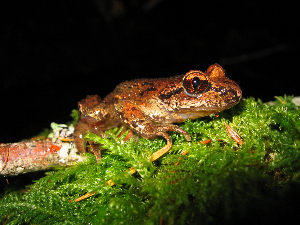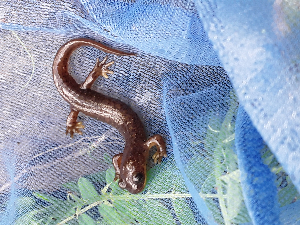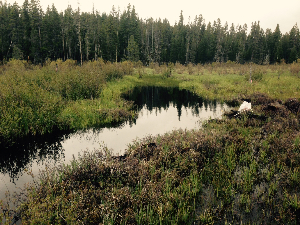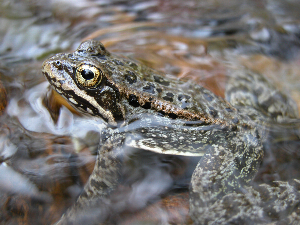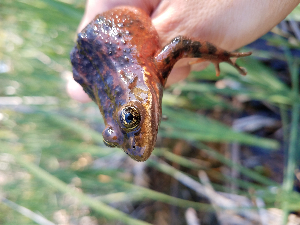Search ARMI Database
Search term(s)
Contribution Number
Search Results
74 record(s) found.
News & Stories Trout, beavers, droughts, and 'precious' frog
The Oregon spotted frog’s scientific name is Rana pretiosa, which translates to “precious frog” in Latin. Precious things are often rare, which is the case with the Oregon spotted frog across parts of its range. It was listed as threatened under the Endangered Species Act in 2014. Although several threats are responsible for the Oregon spotted frog’s decline, loss of the wetland habitat it needs to survive is at the top of the list. The U.S. Fish and Wildlife Service’s national report on wetlands status and trends reveals nationwide losses. In the Klamath Basin of Oregon and California, it’s estimated that 50-90% of the Oregon spotted frog’s wetland habitat has been lost due to habitat modification and prolonged drought.
U.S. Geological Survey scientists are working with other federal agencies, non-profit organizations, and private landowners to research the effectiveness of restoration projects for multiple species and aid in the recovery of the Oregon spotted frog.
“As landowners working to benefit wildlife, livestock, ecosystem health and water quality, partnering with scientists to research the Oregon spotted frog is a vital piece of our restoration ranching approach,” says Alex Froom, owner of a ranch on the Wood River in Oregon. Restoration work on their ranch includes removing invasive bullfrogs and improving habitat for Oregon spotted frogs.
The non-profit Trout Unlimited, whose work in the Klamath Basin is focused on restoring healthy ecosystems for fisheries, amphibians, and other aquatic species, is a key partner working closely with USGS. Several of the strategies being deployed on federally managed land and private ranches are aimed at improving the drought resilience of aquatic habitats, benefiting a wide range of species.
Historically, the range of the Oregon spotted frog overlapped with that of the North American beaver. Beaver numbers in the Pacific Northwest declined dramatically due to the fur trade in the late 1700s and early 1800’s, as did the ecosystem services they provide. Beaver dams and associated ponds retain water in landscapes that otherwise would not hold it. Warmer water along pond edges promotes development of frog eggs and tadpoles and provides adult frogs with feeding and basking areas. Radio telemetry studies suggest Oregon spotted frogs use other beaver-created features like channels and dams as shelter during the winter. Mimicking these features, or enhancing remnant channels and dams, are possible solutions for improving water retention, increasing shelter opportunities and providing additional habitat.
USGS monitoring of Oregon spotted frog populations is showing early signs of success with these types of projects.
In the longest running study of its kind in the Klamath, USGS researchers counted Oregon spotted frog egg masses and adults along Jack Creek on U.S. Forest Service and private land. Surveys were done at reference sites with no habitat modifications, sites where old beaver ponds were excavated and deepened, and sites that were excavated but had no remnant beaver ponds.
Thirteen years of annual sampling revealed that survival of adult Oregon spotted frogs was almost 20% higher at reaches with excavated remnant beaver ponds compared to reference sites. Satellite images revealed that vegetation at restored sites stayed green later into the summer- an indicator of improved water retention. One promising clue that restoration of this type can work was the fact that frog breeding was concentrated in two excavated beaver ponds relative to other sites.
At a site on Crane Creek, USGS scientists partnered with the U.S. Fish and Wildlife Service, Trout Unlimited, and the owner of the Sevenmile Ranch to collect Oregon spotted frogs prior to stream and riparian restoration. Restoration work included redirecting water from a canal back into historical creek meanders and creating a series of ponds. Once restoration was complete, researchers released the frogs and monitored where they went and where they chose to lay eggs. Numbers of egg masses and adults increased in restored areas, indicating modifications to the habitat were favorable for breeding success and survival.
“So far, we’ve seen a noticeable response from Oregon spotted frogs at one site, a smaller but still positive response at another site, and it’s still too early to tell how frogs will respond at two other sites,” says Christopher Pearl, wildlife biologist at the USGS Forest and Rangeland Ecosystem Science Center in Corvallis, Oregon. “The signs are encouraging, and we’re also learning a lot about habitat requirements and behavior of Oregon spotted frogs that will help our partners plan future restoration projects.”
That knowledge about how Oregon spotted frogs respond to habitat modifications is directly used for restoration and recovery planning. The U.S. Fish and Wildlife Service is responsible for assessing the recovery of threatened species and reevaluating listing under the Endangered Species Act.
“We’ve been working in partnership with the USGS for over two decades on all aspects of Oregon spotted frog conservation and recovery,” says Jennifer O’Reilly, biologist with the U.S. Fish and Wildlife Service and Oregon spotted frog species lead. “USGS has a strong understanding of the Service’s role in implementing the Endangered Species Act and has contributed research that’s crucial to our decision making.”
North American beaver populations are slowly recovering in the Pacific Northwest, and USGS is working with partners to study how Oregon spotted frogs respond to the arrival of beavers and newly constructed dams and ponds. Human-led wetland restoration is generating results now, but beaver may lead the way in the future. Either way, USGS scientists will be there to document the Oregon spotted frog’s recovery.
Papers & Reports Bayesian networks facilitate updating of species distribution and habitat suitability models
Data Release Mercury concentrations in amphibian tissues across the United States, 2016-2021
Papers & Reports Adjacent and downstream effects of forest harvest on the distribution and abundance of larval headwater stream amphibians in the Oregon Coast Range
Papers & Reports Broad-scale Assessment of Methylmercury in Adult Amphibians
Papers & Reports Broad-scale assessment of methylmercury in adult amphibians
Data Release Cascade torrent salamander (Rhyacotriton cascadae) surveys in Oregon and Washington 2022
Data Release Oregon spotted frog (Rana pretiosa) telemetry and habitat use at Crane Prairie Reservoir in Oregon, USA
Papers & Reports Population Dynamics of the Threatened Oregon Spotted Frog (Rana pretiosa) Before and After Drought Mitigation
News & Stories Update to annotated bibliography of grazing effects on amphibians and their habitats
USGS researchers recently published an update to the 2020 ‘Annotated bibliography of grazing effects on amphibians and their habitats’ data release, a global synthesis of literature pertaining to livestock grazing effects on amphibians and their habitats. The update includes an additional 10 grazing-related publications that were released between 2020 and 2021. The data release features an interactive search tool, which has also been updated. Users of the annotated bibliography search tool can query records by user-defined criteria and output results in report format. This tool aids users in synthesizing research related to a range of specific questions and should assist land managers in evaluating and implementing grazing while maintaining habitat for wetland amphibians.
You can access the updated search tool here: https://doi.org/10.5066/P9GGPPF7
Data Release Capture-mark-recapture data for Oregon spotted frogs [Rana pretiosa] along the Deschutes River, Oregon, 2016-2019
Papers & Reports Late-season movement and habitat use by Oregon spotted frog (Rana pretiosa) in a large reservoir in Oregon, USA
Papers & Reports An updated assessment of status and trend for Cascades Frog in Oregon
Papers & Reports Demography of the Oregon spotted frog along a hydrologically modified river
Papers & Reports Oregon spotted frog (Rana pretiosa) migration from an aquatic overwintering site: Timing, duration, and potential environmental cues
Papers & Reports Estimation of metademographic rates and landscape connectivity for a conservation-reliant anuran
Objectives Our objectives were to quantify local persistence, colonization, and recruitment (metademographic rates) in relation to habitat attributes, evaluate the influence of the spatial arrangement of patches on landscape-scale population dynamics, and estimate the scale at which metapopulation dynamics are occurring for the Oregon spotted frog (Rana pretiosa).
Methods We collected R. pretiosa detection/non-detection data and habitat information from 93 sites spread throughout the species’ core extant range in Oregon, USA, 2010–2018. We developed a spatial multistate dynamic occupancy model to analyze these data.
Results Results indicated the proportion of sites occupied by R. pretiosa was relatively stable despite regular turnover in site occupancy. Connectivity was highest when the distance between sites was within 4.49–https://7.70 km, and populations within 1 km are at the appropriate spatial scale for effective population management. Rana pretiosa metademographic rates were strongly tied to water availability, vegetation characteristics, and beaver dams.
Conclusions Our analysis provides critical information to identify the appropriate spatial scale for effective population management, estimates the distance at which populations are connected, and quantifies the effects of hypothesized threats to species at a landscape scale. We believe this type of model can inform conservation and management strategies for multiple species.



